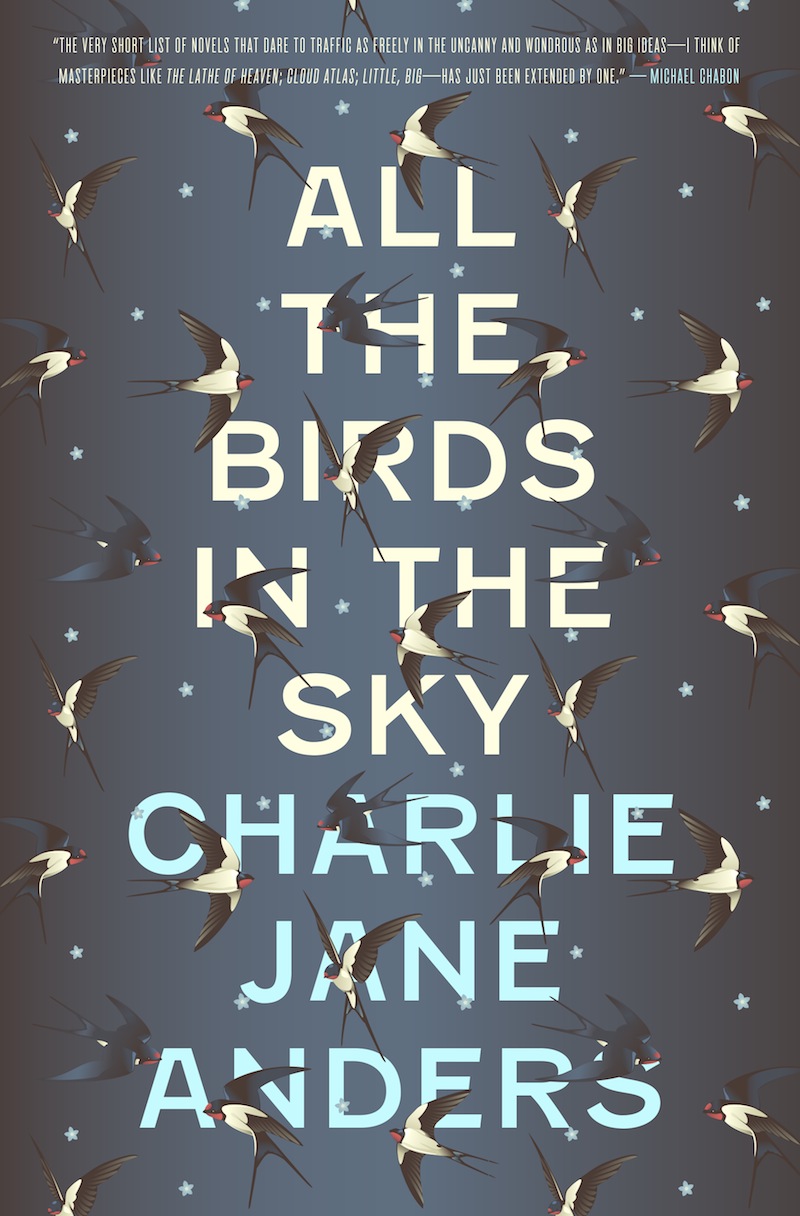All the Birds in the Sky Review: Surviving the Apocalypse with Magic and Technology

All the Birds In the Sky by Charlie Jane Anders is a delightfully disruptive novel. With protagonists coming from opposing worlds, magic and science, this book defies not only the schism of its own genre (sci-fi/fantasy), but the illusion of duality in the first place. By challenging the symbolism of various dichotomies, Anders proposes a refreshingly sincere answer to the apocalypse: that empathy and love can save us from extinction.
WARNING: Spoilers ahead.
At first, All the Birds reads like a typical YA novel, complete with social injury and ostracization. Don’t get me wrong. I enjoyed the emo-tinged misadventures of Patricia Delfine and Laurence Armstead. They made me relive the unironic yet cringing feeling of adolescence in a way that other YA characters have not. Still, even our protagonists’ roles seem to be typical. Patricia is a powerful witch with a guilty conscience. Laurence is a precocious yet insecure techie.
Traditional media has gendered witchcraft as female and tech as male. However, Anders battles the delusions of gender dynamics with subtlety and compassion. Laurence illustrates this beautifully when he confides to Patricia: “You know… no matter what you do, people are going to expect you to be someone you’re not. But if you’re clever and lucky and work your butt off, then you get to be surrounded by people who expect you to be the person you wish you were.” Instead of resigning to the trap of expectations, Laurence and Patricia ultimately choose to be free by accepting each other as they are.
Anders’ characters are liberated from other dichotomies, mainly that of Nature and Technology. Though commonly depicted as enemies in other sci-fi books, these forces unite in All the Birds. First, Anders shows us how destructive it can be when they are divided. Ernesto—a witch who, for centuries, has carried a curse that can only be likened to a “Miracle-Gro” bomb—says that “we could not ‘break’ nature if we spent a million years trying. This planet is a speck, and we are specks on a speck. But our little habitat is fragile, and we cannot live without it.” Though nature is resilient, we, as a species, are at its mercy.
Nature is indifferent to human extinction until it meets its counterpart, which comes in the form of a sentient A.I. named Peregrine. Again, we see how one force alone falls short in saving humanity. As society collapses under climate change disasters, Peregrine tells Laurence, his co-creator (Patricia is the other), “I think you’re just disappointed that I haven’t transformed the entire planet, or become some sort of artificial deity, which seems like a misapprehension of the nature of consciousness, artificial or otherwise.” By taking a jab at the Deus Ex Machina trope, Anders unveils her alternative solution, one that is woven seamlessly throughout the book.
From the beginning, we see the push and pull of “Past vs. Future.” As children, Laurence makes a time machine that can only jump forward while Patricia speaks to an Ancient tree spirit. In the upcoming apocalypse, Patricia and the witches would help humanity devolve into an arcadian, vaguely savage existence. Laurence and his fellow scientists would sacrifice the entire planet to build a portal to another one. Both solutions involve killing most of the population. They run away—in opposite directions—from the problem instead of facing it head on.
Ultimately, Patricia and Laurence choose to tackle the issue by staying present, which requires both observation and participation. An inevitable side effect of such attentiveness is empathy. This value is expressed through Serafina, the book’s emotional robot creator, who says, “We don’t need better emotional communication from machines. We need people to have more empathy. The reason the Uncanny Valley exists is because humans created it to put other people into. It’s how we justify killing each other.” In other words, dehumanization is a form of denial we use to defend bombing countries, fracking towns, etc.
To dissolve destruction, we need empathy. It aids our ability to love and think in plurality, which in turn, connects us and helps us see the responsibility we have for each other. The unbreakable bond of Anders’ protagonists creates a being that can truly relate to nature and free it from isolation. Peregrine helps nature understand humans enough to actually save them. While this solution is fantastical, the empathy that Laurence and Patricia have for each other is within reach. Yet, Anders balances this idea with humility when she writes, “Love was the most susceptible to random failure of all human enterprises.” Acknowledging that everything could end anyway is a risky move in a genre dominated by triumphant heroes. It is what makes All the Birds more visceral, relevant, and powerful.
All the Birds in the Sky is entertaining without being escapist. Rarely has a sci-fi/fantasy novel proposed ideas and solutions that can be applied in the real world without the aid of particle beams or dragons. Instead of a Chosen One championing one force and leading the way to utopia, we have two protagonists who defy dualism and its expectations—all to create something attainable: a more accepting and understanding society that just might save itself from itself.
NYC native Camilla Zhang is a writer and editor with a comics background. She has been published in Reading with Pictures and is a recent runner-up in Top Cow’s 2015 Talent Hunt. You can find more of her work on her website and follow her on Twitter.
—Please make note of The Mary Sue’s general comment policy.—
Do you follow The Mary Sue on Twitter, Facebook, Tumblr, Pinterest, & Google +?
Have a tip we should know? tips@themarysue.com